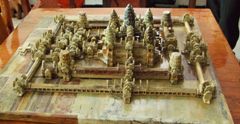Preah Vihear Temple
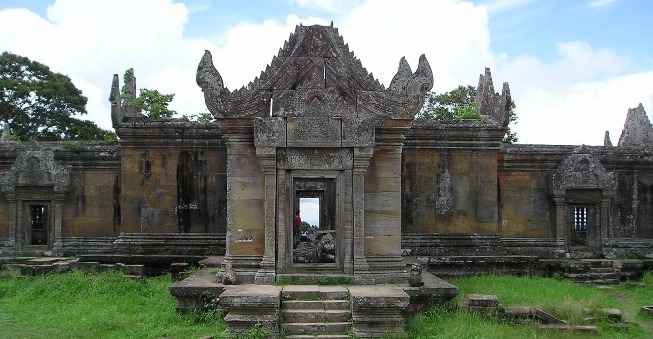
Preah Vihear Temple is located in Northern part of Cambodia, in the province of Preah Vihear and is about 625 km from the capital city of Phnom Penh. It is situated in a pleasant environment with an attractive countryside slightly east of the midsection of the Dongrek Mountains, a forested range of hills averaging 1,500 2,000 feet (450 600 m) that divides Thailand and Cambodia. The temple was built on the hillside overlooking Cambodia some 600 meters below, from the edge of a gigantic cliff. It is about 625 meters above sea level.
The Temple of Preah Vihear is dedicated to Shiva. The Temple is composed of a series of sanctuaries linked by a system of pavements and staircases over an 800 meters long axis and dates back to the first half of the 11th century AD. Nevertheless, its complex history can be traced to the 9th century, when the hermitage was founded. The Khmer began building Prasat (temple) Preah Vihear in 9th century atop of a mountain cliff, overlooking a vast plain and mountain range. At the time, Cambodian western territory extended as far as present Burma and northern territory as far as Chieng Mai, Thai 's province. For centuries, it was a sanctuary dedicated to Hindu god Shiva. The construction was accelerated during the reigns of the kings Suryavarman I (1002 -1050) and Suryavarman II (1113 -1150). Its architecture resembles the style of Koh Ker (early 10th century), and Banteay Srey (late 10th century). It adapted to the natural environment and religious function.
Suryavarman II, the main architect of most Khmer temples during his reign, wanted to increase the prestige and natural beauty of the Khmer temples, changed the original small sanctuary into one of the greatest Khmer temples of all times. The result was the finest carving statues that depicted the highest standard and unique Khmer architecture. There are many exceptional quality carved stone ornamentations which made the temple extraordinary. Undoubtedly, the temple has the most remarkable setting of all the Khmer architects anywhere in Cambodia.
The temple complex runs about 800 meters north-south axis. It has four levels and four courtyards. The temple has four levels and four courtyards. Palace Building was the King 's residence when he came to pay homage to the mighty God. The two wings were the shelters for the pilgrims. The main temple is used for the high-ranking supreme divinities.
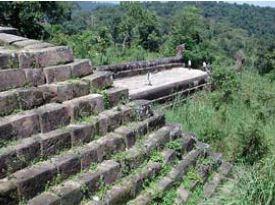
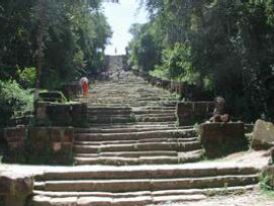
The front stone stairway is a main passage on the North side. The stairway is 8 meters wide and 78 meters long. The first flight has 162 steps. The first landing is a large stone statue. Another 54 flight of steps 4 meters wide and 27 meters long leads up to the second landing. It is also decorated with stone statue. The Nagaraj Courtyard is a stone-paved, 7 meters wide by 31.8 meters long leads up to the first level. The stair rails are in the form of seven-headed snakes called "Ngu Suang " facing North towards the temple. A shorter avenue leads to level 3, the first courtyard of the temple which resembles Angkor Wat architecture. A short causeway decorated with nagas leads to the inevitable level 4 where the second courtyard, known as Galleries, and the Main Sanctuary are located.
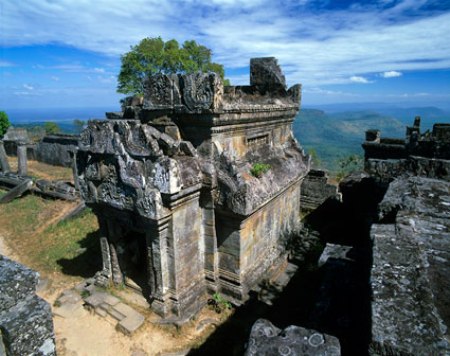
The art of carving found at Preah Vihear buildings represents an outstanding masterpiece of Khmer architecture, both in plan and in the detail of its decoration. The building materials, mainly carved stones, express well the values of the property. The site is exceptional for the quality of its architecture, which is adapted to the natural environment and the religious function of the temple, as well as for the exceptional quality of its carved stone ornamentation. The temple complex located at the remote area and has been abandoned for so long that the integrity of the property has been compromised. It has been rediscovered and going forward, protective measures for the Temple must be adequately addressed.
This main 11th century temple site was a dispute between Cambodia and Thailand. During the French colonial era, Cambodia lost a vast area of territory. Today, the temple is situated on the edge of a plateau at Cambodian-Thai border. The geographic location is a subject of an emotional dispute between Thailand and Cambodia. In 1904, Siam and the French colonial authorities, based on their border commission works, placed Prasat Preah Vihear on Thai side. In 1907, French officers drew up a new map, showing the temple on Cambodia side. In 1954, Thai forces occupied the temple following the withdrawal of French troops from Cambodia. Cambodia protested, and in 1959, asked the International Court of Justice to rule on the ownership.
Former U.S. secretary of state Dean Acheson was an attorney for Cambodian government. Thailand 's legal team included a former British attorney general, Sir Frank Soskice. Based on the Franco-Siamese Treaty of 1904 and 1907, the border line between Cambodia and Thai along the Dongrak Mountains, on June 15, 1962, the Justice at the Hague officially found that Preah Vihear Temple situated inside Cambodia territory, by a vote of 9 to 3.
The Preah Vihear site is flat and is easily accessible from Thai ' side. From Cambodia ' side, it is hilly and rough to get to the top. Over the years when Cambodia plunged into a civil war, visitors come to visit Preah Vihear from Thailand. Preoccupied with the war and unrest, Cambodian government was not able to effectively control its border and the tourism is booming at the Thailand 's side. When the war was over, the Cambodian government took control and has attempted to make the site easily accessible. On July 8, 2008, the World Heritage Committee decided to add Prasat Preah Vihear to the World Heritage Site list, sparkling another emotional claim of ownership. Without a doubt, the temple has the most remarkable setting of all the Khmer architects anywhere in Cambodia. Moreover, an International Court ruled in 1962 awarded the ownership to Cambodia.



